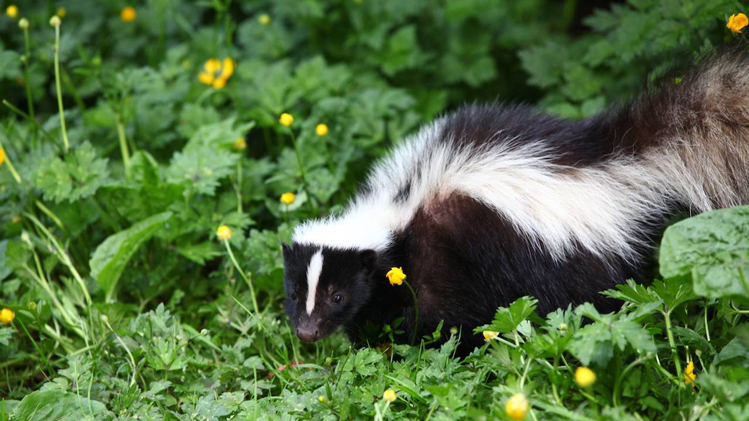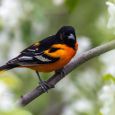The Gift of South Dakota
Subscriptions to South Dakota Magazine make great gifts!
Subscribe today — 1 year (6 issues) is just $29!
Embrace the Funk
May 8, 2019
 |
| Could skunks be considered our misunderstood friends of the animal kingdom? |
Skunks get a bad rap. Processes evolutionary (or divine) enhanced their ani with powerful stink glands they can weaponize when threatened.
Their distinctive color schemes are also aposematic, reminding potential predators that they come strapped with the stink gun. That aposematism has also permeated the human psyche. When was the last time you saw a runway model rock a skunk hat?
But maybe it's time we reach out to our striped (or sometimes spotted) sisters and brothers. They just want to be free to go about their skunky lives in peace. Their anal defense isn't a weapon of war — it's a unilaterally-imposed armistice, peace through stank.
The chemical compounds that make skunk spray so noxious are called thiols. Thiols in onions make you cry. Your colleagues might notice the thiols from the garlic chicken you had at the lunch buffet. But in the right proportions, that garlic and onion funk adds flavor to your life. Similarly, some people openly enjoy the sweetish fragrance of a dissipated skunk spray.
Skunk evolution engineered a way to leverage the skunky goodness in your French onion soup into a recipe for not being dinner. Maybe that deserves some respect.
"I find skunks to be endlessly fascinating because they are so fearless yet non-aggressive," says Dr. Ted Stankowich, who directs research into evolutionary behavioral ecology at California State University. "They go about their night looking for food and won’t bother you or other creatures, but if you harass them or get too close, they will strongly signal that you’d better move away. Skunks don’t want to spray you — so they’ll do everything in their power to tell you to leave without actually spraying."
Before spraying, a striped skunk will methodically check off a list of warning behaviors. (Mephitis mephitis is the only skunk common in South Dakota, although the plains spotted skunk — Spilogale putorius interrupta — can be found). "It first and almost universally will raise its tail," says Stankowich. "It may foot stamp with its front feet, charge at the intruder, and even hiss. Finally, it will turn and aim its rear end toward the predator, in a final warning, before it actually sprays."
Skunks are natural-born de-escalators. You almost have to want a skunk bath (or be a dog) to get sprayed.
So, while there's no dearth of searchable articles on how to get rid of backyard skunks, this how-to is for those who choose coexistence with our striped or spotted cousins.
FOOD & DRINK
"If you actually want skunks in your yard, leaving fruit, nuts and especially dry cat food scattered about would be a dream come true for them," says Stankowich. "When we want to keep a skunk in a particular area of grass for a behavioral experiment, we scatter dry cat food all over the place and they’ll spend a long time eating it up. Leaving pans of clean water would draw them in too — especially in dry times of the year. Skunks require a nearby source of water, and having a watering station would encourage them to come back."
"Skunks are omnivores and eat a wide variety of food, including small mammals, amphibians, insects (one third to one half of their diet), eggs, small birds, fruits and nuts. Most of these are found on the ground or under the grass, so they keep the insect and small pest populations down to some extent."
SHELTER
Building a skunk hotel may also help attract our misunderstood friends. "If you want skunks to den in your yard, piles of rocks or wood with cavities underneath would be ideal den sites. We often find them under rotting stumps, piles of old wood or asphalt, and under homes or other structures. So providing shelter with a natural cavity will help."
BENEFITS OF BUILDING SKUNK HABITAT
You'll get some insect and rodent control out of the deal. And you may even increase your chances for owl visitation. "Skunks are only rarely killed by other mammals," says Stankowich, "but more commonly by owls." Skunk enthusiasts may undergo an emotional tug of war watching an enormous great horned owl carry off the creatures we welcomed into our outdoor abode. But skunk lovers are a tough breed.
RARER SKUNKS
Some lucky homeowner may even see the less common plains spotted skunk take up residence.
"We do not know exactly how this species’ distribution has changed, but we hear from many people that they do not see as many spotted skunks today as in the past," says Eileen Dowd-Stukel, a wildlife biologist for South Dakota Game, Fish and Parks, and co-author of Sharing Your Space: A Homeowner's Guide to Attracting Backyard Wildlife.
"That is apparently true in other areas, and the U.S. Fish and Wildlife Service is reviewing the status of this subspecies to see if listing under the federal Endangered Species Act may be needed. We have secured funding for a project to be conducted through Kansas State University to learn more about distribution, habitat needs, and survival rates. This information will help us better understand what may be limiting the spotted skunk in South Dakota."
"As far as attracting skunks, providing diverse habitats, including areas of cover for both the skunks and potential prey, are helpful. We’ve lost many old farmsteads that previously had the mixture of shelter sources and habitat types that sustained spotted skunks."
Michael Zimny is the social media engagement specialist for South Dakota Public Broadcasting in Vermillion. He blogs for SDPB and contributes arts columns to the South Dakota Magazine website.










Comments